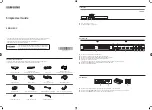
6
6-1
6-2
20CT
-250
PIF/AFT/AGC ADJUSTMENT
No. Adjusting point
Adjusting procedure/conditions
Waveform and others
VCO adjust-
ment: T203
1. Disconnect the antenna from the tuner antenna
terminal.
2. Apply DC voltage to pin (4) of IC201 (IF AGC).
»
DC voltage: 6.0 V (all0.1 V)
3. Using a digital voltmeter, measure the DC volt-
age at pin (20)(PLL FIL) of IC201.
* The digital voltmeter must be able to take read-
ings down to the third decimal place.
4. Relieve pin (4) of IC201 of the DC voltage.
5. Reconnect the antenna in position and receive
the E-12CH signal. (With the AFT off, adjust the
receiving frequency to 224.25 MHz.)
6. Connect the DC digital voltmeter to pin (20) of
IC201. Adjust T203 so that the voltmeter should
read the same voltage as in Step 3.
Allowable error : 0.015 V (20 kHz)
1
* Warm up the unit for longer than
10 minutes in advance.
* 10 kHz at about 0.007 V.
* Position the T203 core in the
range in which the Colour Bar
signal can be received.
AFT
adjustment:
T204
1. Receive the PAL Colour Bar signal. If this signal
is not available, any signal above the E-5CH band
is acceptable.
»
Field strength : 55-80 dB
µ
V
Make sure the frequency is almost the same as
that of the received channel (±30 kHz).
2. Using the channel setting control, make a fre-
quency of 224.25 MHz appear on the screen (the
AFT turns off). If any other channel than Colour
Bar is received, make its frequency on the screen.
(The AFT turns off when the on-screen display
turns yellow.)
3. Turn T204 clockwise to have a 6V point, and
counterclockwise to have a 0.2V point. Position
the coil at the center of these two points.
4. Adjust T204 so that the DC voltage at pin (1) (AFT
OUT terminal) of IC201 be 3.3 ±0.1 V. (See
Fig. 3)
2
RF AGC
cut-in
adjustment:
R216
1. Receive the PAL Colour Bar signal.
»
Field strength : 57 ±1 dB
µ
V (75 ohms open)
2. Connect the oscilloscope to TP210, as shown in
Fig. 4.
3. Turn R216 to have the highest voltage.
4. Turn R216 slowly in the opposite direction until the
voltage goes down 0.1 V below the highest level.
5. Adjust the signal level to 63-67 dB
µ
V and make
sure there is no noise.
6. Now adjust the signal level to 90-95 dB
µ
V and make
sure there is no chrominance modulation beat.
3
6V
3.3V
DOWN A
B'
B
B" C UP
DC voltage at TP201
Fig. 3
»
Bias box: About 4.5 V
Oscilloscope
0.1V
TV Set
Bias box
TP210
+
+
–
–
Fig. 4
PIF CHECKING
No. Adjusting point
Adjusting procedure/conditions
Waveform and others
Tuner IFT
(preset):
TU201
1. Get the tuner ready to receive the E-9CH signal.
but with no signal input. Adjust the PLL data.
2. Connect the sweep generator’s output cable to
the tuner antenna. (RF sweep)
3. Adjust the sweep generator’s output level to 80
dB
µ
V.
4. Connect the response lead (use a low-impedance
probe with wave detector; see
Fig. 1) to the tun-
er’s IF output terminal.
(This terminal must have the probe alone con-
nected.)
5. Set the RF AGC voltage to 0-6 V with no contact
with the waveform.
6. Adjust the tuner IF coil to obtain the waveform as
shown in
Fig. 2.
Note: Be sure to keep the tuner cover in posi-
tion during this adjustment.
1
IF-OUT
1000p
10k
Ω
75
Ω
1000p
100k
Ω
Oscilloscope
Fig. 1
E-9CH
P
C
– 1.5dB
±
0.8dB
Fig. 2
SERVICE ADJUSTMENT
115V ADJUSTMENT
No. Adjusting point
Adjusting procedure/conditions
Waveform and others
115V
adjustment:
R711
1. Receive the Monoscope Pattern signal.
2. Set to the P-NORM mode.
3. Connect a DC milliammeter between TP602(–)
and TP603(+).
4. Take the beam ammeter reading to make sure
that the beam current is between 900
µ
A and
1100
µ
A.
* If not, readjust the FBT screen control to ob-
tain the beam current of 900-1100
µ
A.
5. Connect a digital voltmeter to TP701.
6. Adjust R711 so that the digital voltmeter should
read 115 ±0.5 V.
1







































